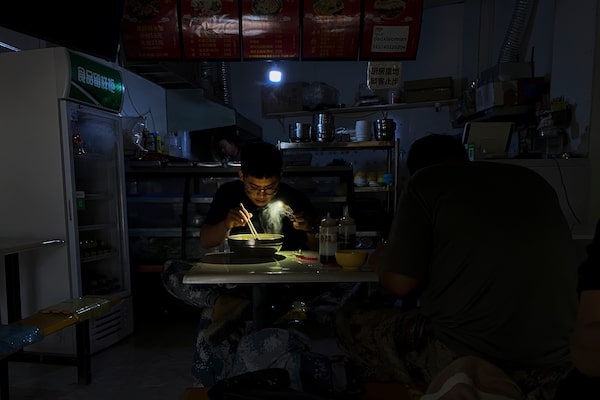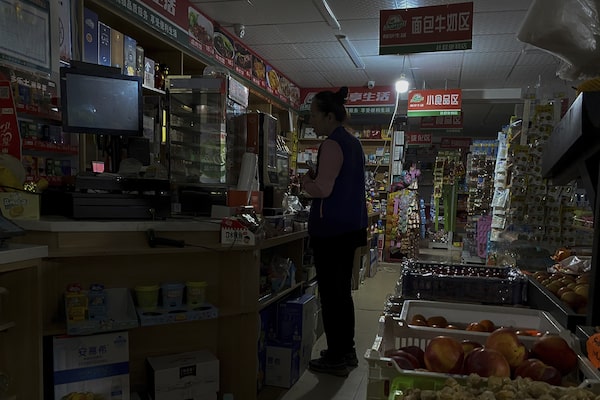
A man uses his smartphone flashlight to light up his bowl of breakfast noodles at a restaurant during a blackout in Shenyang, in northeastern China's Liaoning province, on Sept. 29.Olivia Zhang/The Associated Press
China is grappling with a power crunch that threatens to curb economic growth and worsen product shortages that have roiled global supply chains in recent months.
Surging coal and gas prices, as well as rising demand for electricity amid a boom in manufacturing and exports, have led to severe power shortages across China, with more than half of all provinces reporting problems.
The shortages have resulted in rolling blackouts in some areas, and factories have been forced to close or suspend operations during certain hours to conserve power.
The impact on industries is broad and includes power-intensive sectors such as aluminum smelting, steelmaking, cement manufacturing and fertilizer production. Suppliers for Tesla Inc. and Apple Inc. have also reportedly been forced to halt production.
Analysts are concerned that knock-on effects could damage the wider Chinese economy, potentially dwarfing any problems caused by the collapse of real estate giant Evergrande, which has dominated headlines in the past month.
A number of banking giants – including Goldman Sachs Group Inc. – have cut their forecasts for Chinese growth this year, citing the power disruptions.
The outages are just the latest headwind for the Chinese economy. Manufacturing output fell in September, ending an 18-month expansion. Consumer spending is slowing. And the country is awash in debt, whether at the government or household levels.
Any troubles in China could have far-reaching implications for a global economy that, over the past two decades, has increasingly relied on the country to drive growth. Of late, China has played a central role in troubled supply chains, owing to intermittent shutdowns at factories and ports as Beijing looks to stamp out the COVID-19 virus.
The power shortages are liable to make the supply situation even worse.
“Beijing’s unprecedented resolve in enforcing energy-consumption limits could result in long-term benefits, but the short-term economic costs are substantial,” analysts at Japanese financial holding company Nomura said in a recent report.
While China is shifting to greener energy production, coal still fuels some 67 per cent of the country’s power generation, the report said. Coal costs are soaring worldwide, but strict government limits on electricity pricing have prevented power companies from passing on increased costs to consumers, leading some to cut production.
Even provinces with plenty of energy to go around are still experiencing power shortages as their governments try to hit national energy-consumption targets for the third quarter. In August, the National Development and Reform Commission (NDRC) warned that two-thirds of all provinces had missed their targets in the first half of the year.

A woman buys groceries during a blackout in Shenyang. The light bulb is powered by a gasoline generator.Olivia Zhang/The Associated Press
That prompted some local governments to impose rolling blackouts this month, often with little warning. It led to traffic chaos after street lights stopped working, and there were reports of people being trapped in elevators or forced to walk up dozens of flights of stairs. In the northern Liaoning province, 23 workers at a foundry suffered carbon-monoxide poisoning after a blackout shut down the ventilation system, state media reported.
In an opinion piece published Sunday in the People’s Daily, the mouthpiece of the Chinese Communist Party, local governments were told not to be “too aggressive” or “slam the brakes too hard” in cutting energy consumption.
“No matter how tight the power supply is, we must give priority to guaranteeing residents’ electricity use,” it said, warning of potential societal unrest.
At a news conference on Wednesday, officials from the NDRC echoed this guidance, saying the party “attaches great importance to the work of ensuring energy supply during the heating season.”
The NDRC said it will add advanced coal-production capacity, increase coal imports and try to increase domestic natural-gas production in order to relieve the current crisis. On Thursday, authorities in Heilongjiang province said they would ramp up the amount of electricity imported from Russia to ease local power shortages.
However, on the same day, the China Coal Industry Association warned that inventory at power plants is low and it is “not optimistic” ahead of the winter, the season of peak demand.
There was evidence of public anger over the blackouts being censored online. Both FreeWeibo and FreeWeChat, services that monitor censorship on China’s biggest social-media platforms, showed many posts being deleted.
In an editorial this week, state-run tabloid Global Times attacked foreign media for launching “a new wave of criticism badmouthing China’s economy and raising the alarm,” adding that “this power crunch is not a crisis for China.
“China is prompt in discovering and discerning problems, and public opinion has played a positive role in it,” the paper said.
While the manufacturing hubs of southeastern China have been among the worst-hit this month, residents of northern provinces are fearful that the shortages could continue into the bitterly cold winter, bringing widespread misery and even death.
“Even with prior notice, no electricity equals no heating, how would we live through this winter?” wrote one user on Weibo, China’s equivalent to Twitter.
The temperature regularly plunges below -20 across northeastern China, where households are largely dependent on coal for heating – though some have moved to electric heaters in recent years.
One Weibo user in Jilin province, on the border with North Korea, said that without power, “taking a hot bath is impossible, eating a hot meal becomes a luxury. Are we really going to live like ancient human being? … Read our books by oil lamp?”
With reports from Alexandra Li, Matt Lundy, Reuters and The Associated Press
Our Morning Update and Evening Update newsletters are written by Globe editors, giving you a concise summary of the day’s most important headlines. Sign up today.
 James Griffiths
James Griffiths